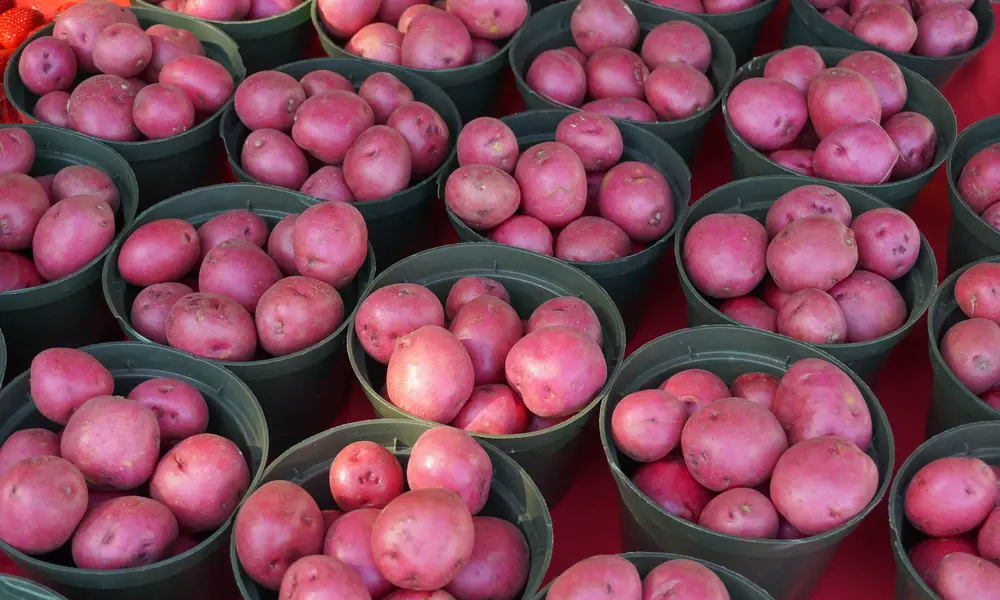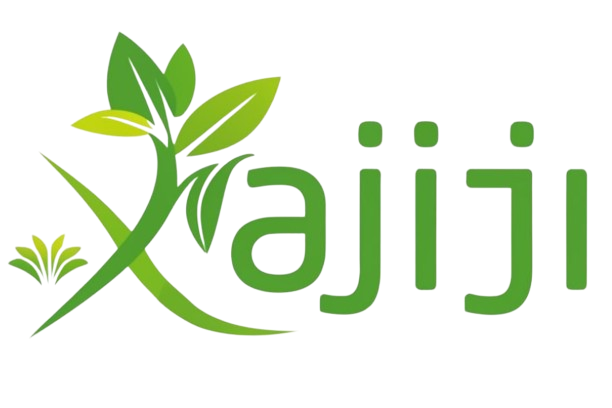When it comes to growing Pontiac Red Potatoes, like any other crop, gardeners often encounter common problems that can hinder their success. But fear not!
We will examine these prevalent issues in-depth in this comprehensive book, supported by extensive research, to give you workable solutions.
From dealing with pests and diseases to optimizing growing conditions, we promise to equip you with the knowledge and strategies to overcome these challenges.
We aim to ensure your journey of cultivating Pontiac Red Potatoes is not only productive but also enjoyable. So, let’s explore the issues, uncover the solutions, and share valuable insights to help you achieve a thriving harvest of Pontiac Potatoes.
Table Chart For The Red Pontiac Potatoes
Here’s a simplified table chart for the Red Pontiac Potatoes growing guide:
| Growing Aspect | Recommendation |
|---|---|
| Water | Regular watering to maintain even moisture. |
| Light | Full sun (6-8 hours per day). |
| Soil | Well-drained, loamy soil (pH 5.8-6.5). |
| Temperature | Cool temperatures (60-70°F/15-21°C). |
| Fertilizing | Balanced fertilizer before planting, side-dress during growth. |
| Harvesting | Dig when plants yellow and die back (80-100 days). |
| Storage | Cure for 2 weeks in a cool, dark area. |
| Common Problems | Potato Blight, Common Scab, Mosaic Virus, and more. |
Where to Buy Red Pontiac Seed Potatoes
Before diving into the growing process, it’s essential to know where to source your Red Pontiac seed potatoes.
Local nurseries, garden centers, and online suppliers are excellent options for purchasing high-quality seed potatoes. Look for certified disease-free varieties to ensure healthy plants.
Preparing Seed Potatoes for Planting
Properly preparing your seed potatoes is crucial for a successful harvest. Start by selecting firm and healthy potatoes. About two weeks before planting, place them in a cool, well-lit area to encourage sprouting.
Cut larger potatoes into smaller pieces, ensuring each piece contains at least one eye or sprout. Allow the cut surfaces to dry and callus over for a day or two to minimize the risk of rot.
When to Plant Red Pontiac Potatoes
Pontiac potatoes thrive in cool climates and should be planted in early spring, as soon as the soil can be worked. The ideal soil temperature for planting is around 45 to 55°F (7 to 13°C). Ensure any risk of frost has passed before planting.
How to Plant Red Pontiac Potatoes
To plant Red Pontiac potatoes, choose a location with well-drained soil and full sun exposure. Dig trenches or individual holes, spaced about 12 inches apart.
Place the seed potatoes in the trenches or holes, eyes facing upward, and cover them with 3-4 inches of soil. As the plants grow, gradually mound soil around the stems to promote tuber development.
Potato Growing Underground
How to Grow Red Pontiac Potatoes
Growing Pontiac Red potatoes requires consistent care throughout the season.
Here are some essential tips to help you achieve a bountiful harvest:
Water Requirements: Provide regular, deep watering to ensure the soil remains evenly moist. Avoid overwatering, as it can lead to rotting.
Light Requirements: Red Pontiac potatoes thrive in full sun. Aim for at least six to eight hours of direct sunlight per day.
Soil Requirements: Well-drained, loamy soil with a pH between 5.8 and 6.5 is ideal. Prepare the soil by incorporating organic matter such as compost or aged manure.
Temperature Requirements: Pontiac Red potatoes prefer cool temperatures, around 60 to 70°F (15 to 21°C). Higher temperatures can inhibit tuber formation.
Humidity Requirements: Moderate humidity levels are suitable for Pontiac potatoes. Adequate air circulation can help prevent diseases.
Fertilizing Requirements: Before planting, apply a balanced fertilizer with a ratio of 10-10-10. Side-dress with compost or a nitrogen-rich fertilizer during the growing season.

Companion Plants for Red Pontiac Potatoes
Companion planting can provide benefits such as pest control and improved growth. Suitable companions for Pontiac potatoes include:
- Marigolds: Their strong scent repels pests like nematodes.
- Horseradish: Acts as a natural pest deterrent.
- Beans: Fix nitrogen in the soil, benefiting potato growth.
- Corn: Provides shade and acts as a windbreak.
Harvesting Red Pontiac Potatoes
Harvesting Red Pontiac potatoes is an exciting culmination of your efforts. Here’s how to do it:
How to Harvest
Red Pontiac potatoes are typically ready for harvest 80 to 100 days after planting, depending on the desired size.
As the plants begin to yellow and die back, it’s a sign that the tubers are mature. Using a garden fork or shovel, carefully dig around the plants, being cautious not to damage the potatoes. Gently lift the tubers from the soil.
How to Store
After harvesting, allow the potatoes to cure in a cool, dark, and well-ventilated area for about two weeks.
This process helps the skin toughen, extending its storage life. Remove any excess soil or damaged potatoes.
Store the cured Red Pontiac potatoes in a cool, dry place, such as a basement or cellar, at a temperature of around 40°F (4°C). Ensure proper air circulation to prevent rotting.
Recipes for Red Pontiac Potatoes
Red Pontiac potatoes are versatile in the kitchen and can be used in various delicious recipes.
Here are two popular options to try:
Roasted Red Potatoes
- Preheat your oven to 425°F (220°C).
- Wash and cut the Red Pontiac potatoes into bite-sized pieces.
- Toss the potatoes in olive oil, salt, pepper, and your favorite herbs or spices.
- Spread the potatoes in a single layer on a baking sheet and roast for 30-35 minutes or until golden brown and crispy.
- Serve hot as a delightful side dish.
Red Potato Salad
- Boil whole Red Pontiac potatoes until tender. Let them cool and then chop them into bite-sized pieces.
- In a bowl, combine the potatoes with chopped celery, red onion, dill pickles, and hard-boiled eggs.
- In a separate bowl, mix mayonnaise, Dijon mustard, vinegar, salt, and pepper to create the dressing.
- Pour the dressing over the potato mixture and gently toss until well-coated.
- Before serving, let the salad cool for at least an hour in the fridge.
Pests Affecting Red Pontiac Potatoes
While Red Pontiac potatoes are relatively resilient, they can still face pest challenges.
Among the typical pests to be on the lookout for are:
Colorado Potato Beetle: These yellow and black striped beetles can defoliate plants. Handpick and destroy them or use organic insecticides.
Aphids: These small, sap-sucking insects can distort leaves and transmit diseases. Control aphids by spraying plants with a strong jet of water or using insecticidal soap.
Slugs and Snails: These mollusks feed on potato foliage and tubers. Use slug traps, barriers, or organic slug pellets to protect your crop.
Diseases Affecting Red Pontiac Potatoes
Red Pontiac potatoes can be susceptible to certain diseases.
Here are a few common ones to be aware of:
Potato Blight: This fungal disease causes dark spots on leaves, stems, and tubers. Use disease-resistant varieties, practice crop rotation, and apply fungicides if necessary.
Common Scab: Scab is a bacterial disease that results in rough, corky patches on the potato skin. Maintain proper soil moisture levels and avoid acidic soils to reduce the risk of scab.
Potato Mosaic Virus: This viral disease leads to stunted growth, mottled leaves, and reduced yields. Control aphids, which transmit the virus, and remove infected plants promptly.
Verticillium Wilt: A fungal disease that causes yellowing, wilting, and death of potato plants. Plant disease-resistant varieties and practice crop rotation to minimize its impact.
Rhizoctonia solani: This fungus causes black scurf on the surface of potato tubers. Implement proper crop rotation and avoid planting potatoes in the same area for consecutive years. Good soil drainage and balanced nutrition can also help reduce the severity of this disease.
Blackleg: Blackleg is a bacterial disease that causes dark, rotting stems and foliage. Use certified disease-free seed potatoes and maintain proper plant spacing and ventilation to prevent their spread.
Powdery Mildew: Powdery mildew appears as a white powdery coating on leaves and stems. Improve air circulation, avoid overhead watering, and apply fungicides to control its spread.
Conclusion
Pontiac Red potatoes are a flavorful and visually appealing variety that can be a rewarding addition to your garden. By following the guidelines outlined in this comprehensive growing guide, you’ll be equipped with the knowledge to successfully cultivate these buried rubies.
From selecting high-quality seed potatoes to caring for the plants throughout the season and tackling potential pests and diseases, you now have the tools to achieve a bountiful harvest.
So, roll up your sleeves, grab your gardening tools, and get ready to enjoy the satisfaction of growing your own delicious Pontiac potatoes.
FAQs
Q1: What are red Pontiac potatoes good for?
Red Pontiac potatoes are versatile and well-suited for various culinary uses. They are particularly good for boiling, baking, roasting, and making mashed potatoes.
Their creamy texture and rich flavor make them ideal for salads, soups, and side dishes. Whether you’re looking to enjoy them as a standalone dish or incorporate them into your favorite recipes, Pontiac potatoes are a delicious and satisfying choice.
Q2: Are red Pontiac potatoes good for mashing?
Yes, Red Pontiac potatoes are excellent for mashing. Their creamy texture and slightly waxy consistency make them ideal for creating smooth and fluffy mashed potatoes.
Q3: Do red Pontiac potatoes keep well?
Yes, Red Pontiac potatoes have good storage capabilities. When stored properly in a cool, dry, and dark place with proper air circulation, they can keep well for several months.
Q4: Are Pontiac red potatoes determinate or indeterminate?
Pontiac Red potatoes are determinate.
